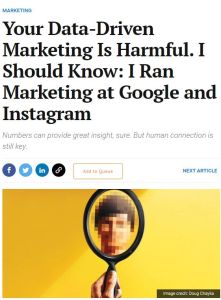
Eric Solomon
Your Data-Driven Marketing Is Harmful. I Should Know: I Ran Marketing at Google and Instagram
Numbers can provide great insight, sure. But human connection is still key.
Entrepreneur, 2020
What's inside?
To succeed in today’s data-driven businesses, marketers need to embrace their humanity.
Recommendation
Eric Solomon was heading global business marketing at Instagram – after senior-level stints at YouTube, Spotify and Google – when a sudden insight spurred him to quit the job and leave his 20-year career behind. In an engaging, at times moving article for Entrepreneur, Solomon describes that turning point, the events that led to it and the conviction that is driving his current work as a consultant, speaker and mentor. Open-minded business leaders at all levels and in any function, not only marketing, will be interested in Solomon’s renegade argument for bringing humanity – and a dose of humility – to today’s increasingly transactional workplace.
Take-Aways
- A quantitative mind-set has led marketers to forget about building relationships with customers as people.
- Businesses are also neglecting their foundational, story-based elements, in favor of measurable operational and transactional functions.
- As ever, marketers need to build emotional connections with customers.
- This point applies to relationships with employees, too.
Summary
A quantitative mind-set has led marketers to forget about building relationships with customers as people.
Since around 2011, marketers – along with the rest of corporate America – have developed a data-driven mind-set. Intuition and gut decision making have given way to quantitative approaches to marketing, and personalization has replaced personal relationships. Granted, marketers may never have truly embraced the notion of human connections as the heart of the profession. But even that ideal has fallen away as the quantitative mind-set has taken over.
“Today, the holy grail of advertising can be framed as personalization meets attribution.”
Businesses are also neglecting their foundational, story-based elements, in favor of measurable operational and transactional functions.
Business activities occur on a spectrum – from the operational/transactional at one end to the firm’s foundational elements at the other. The more operational activities lend themselves to measurement and data-driven approaches. The foundational elements, in contrast, have a more qualitative, emotive, narrative nature: the company’s vision and mission, its core values and purpose, its communication style. You can’t draw a line between the two kinds of activity, and you can’t divorce the emotional aspect from business, at any level. But marketers have been trying by focusing on the measurable, transactional, operational end of the spectrum – because that’s easy – and neglecting the necessary foundational, relationship-based activities.
“Corporate obsession with big data has made it far too easy to ignore the foundational elements of business entirely.”
As ever, marketers need to build emotional connections with customers.
Of course, data have value and quantitative tools work. But marketers shouldn’t discount the importance of building human connections with customers. This begins with remembering that transactions have human beings at the other end. The concept of a “business relationship arc” can organize your thinking about customer relationships. The arc begins with the customer’s first encounter with the brand – similar to your first meeting with a person. As the consumer begins to connect meaning with the brand, the relationship develops. Successful marketing means moving consumers along the arc, to the point where they care about the brand and will even take action on its behalf. To accomplish this, marketers have to understand customers as people. Data based on group behavior won’t suffice.
“We’ll never build truly great, resonant brands if we don’t connect with people as individuals.”
This point applies to relationships with employees, too.
A brand operating system underpins the brand’s purpose and helps drive the company’s activities. A brand operating system rests on an internal belief – such as the belief at Nike that every person, by virtue of having a body, is an athlete. The belief enables and brings coherence to the company’s foundational elements. It also translates into meaning for customers. To build that belief within the organization, leaders need to see employees as people – not just performance data points – and treat them with humanity and humility. Only then will leaders be able to communicate persuasively about the organization’s vision and purpose.
About the Author
Eric Solomon is the chief marketing officer in residence for Novio, a premium creative consultancy that helps give businesses meaning and purpose by telling authentically human brand narratives. He has held senior marketing positions at YouTube, Spotify, Instagram, and other leading technology companies.
This document is restricted to personal use only.
My Highlights
Did you like this summary?
Read the articleThis summary has been shared with you by getAbstract.
We find, rate and summarize relevant knowledge to help people make better decisions in business and in their private lives.
Already a customer? Log in here.


















Comment on this summary